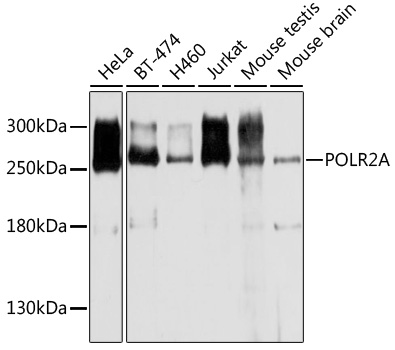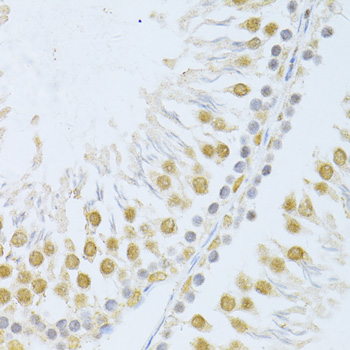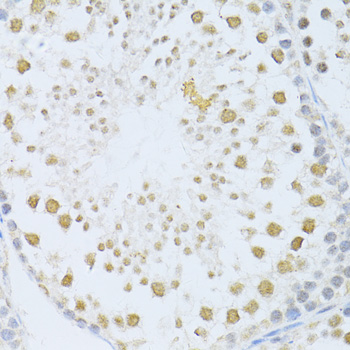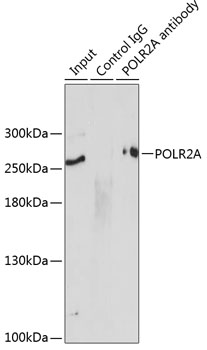Anti-POLR2A Antibody (CAB11181)
- SKU:
- CAB11181
- Product type:
- Antibody
- Application:
- WB
- Application:
- IHC
- Application:
- IF
- Application:
- IP
- Application:
- ChIP
- Reactivity:
- Human
- Reactivity:
- Mouse
- Reactivity:
- Rat
- Host Species:
- Rabbit
- Isotype:
- IgG
- Antibody Type:
- Polyclonal Antibody
- Research Area:
- Immunology
Description
| 抗体名: | Anti-POLR2A Antibody |
| 抗体コード: | CAB11181 |
| 抗体サイズ: | 20uL, 50uL, 100uL |
| 申し込み: | WB IHC IF IP ChIP |
| 反応性: | Human, Mouse, Rat |
| 宿主種: | Rabbit |
| 免疫原: | Recombinant fusion protein containing a sequence corresponding to amino acids 1-260 of human POLR2A (NP_000928.1). |
| 申し込み: | WB IHC IF IP ChIP |
| 推奨希釈: | WB 1:500 - 1:2000 IHC 1:50 - 1:200 IF 1:50 - 1:200 IP 1:20 - 1:50 ChIP 1:20 - 1:50 |
| 反応性: | Human, Mouse, Rat |
| ポジティブサンプル: | HeLa, BT-474, H460, Jurkat, Mouse testis, Mouse brain |
| 免疫原: | Recombinant fusion protein containing a sequence corresponding to amino acids 1-260 of human POLR2A (NP_000928.1). |
| 精製方法: | Affinity purification |
| ストレージバッファ: | Store at -20'C. Avoid freeze / thaw cycles. Buffer: PBS with 0.02% sodium azide, 50% glycerol, pH7.3. |
| アイソタイプ: | IgG |
| 順序: | MHGG GPPS GDSA CPLR TIKR VQFG VLSP DELK RMSV TEGG IKYP ETTE GGRP KLGG LMDP RQGV IERT GRCQ TCAG NMTE CPGH FGHI ELAK PVFH VGFL VKTM KVLR CVCF FCSK LLVD SNNP KIKD ILAK SKGQ PKKR LTHV YDLC KGKN ICEG GEEM DNKF GVEQ PEGD EDLT KEKG HGGC GRYQ PRIR RSGL ELYA EWKH VNED SQEK KILL SPER VHEI FKRI SDEE CFVL GMEP RYAR PEWM IVTV LPVP PLSV |
| 遺伝子ID: | 5430 |
| Uniprot: | P24928 |
| セルラーロケーション: | Nucleus |
| 計算された分子量: | 63kDa/217kDa |
| 観察された分子量: | 250kDa |
| 同義語: | POLR2A, POLR2, POLRA, RPB1, RPBh1, RPO2, RPOL2, RpIILS, hRPB220, hsRPB1, Pol II |
| バックグラウンド: | This gene encodes the largest subunit of RNA polymerase II, the polymerase responsible for synthesizing messenger RNA in eukaryotes. The product of this gene contains a carboxy terminal domain composed of heptapeptide repeats that are essential for polymerase activity. These repeats contain serine and threonine residues that are phosphorylated in actively transcribing RNA polymerase. In addition, this subunit, in combination with several other polymerase subunits, forms the DNA binding domain of the polymerase, a groove in which the DNA template is transcribed into RNA. |
| UniProt Protein Function: | POLR2A: DNA-dependent RNA polymerase catalyzes the transcription of DNA into RNA using the four ribonucleoside triphosphates as substrates. Largest and catalytic component of RNA polymerase II which synthesizes mRNA precursors and many functional non-coding RNAs. Forms the polymerase active center together with the second largest subunit. Pol II is the central component of the basal RNA polymerase II transcription machinery. It is composed of mobile elements that move relative to each other. RPB1 is part of the core element with the central large cleft, the clamp element that moves to open and close the cleft and the jaws that are thought to grab the incoming DNA template. At the start of transcription, a single stranded DNA template strand of the promoter is positioned within the central active site cleft of Pol II. A bridging helix emanates from RPB1 and crosses the cleft near the catalytic site and is thought to promote translocation of Pol II by acting as a ratchet that moves the RNA-DNA hybrid through the active site by switching from straight to bent conformations at each step of nucleotide addition. During transcription elongation, Pol II moves on the template as the transcript elongates. Elongation is influenced by the phosphorylation status of the C-terminal domain (CTD) of Pol II largest subunit (RPB1), which serves as a platform for assembly of factors that regulate transcription initiation, elongation, termination and mRNA processing. Acts as a RNA- dependent RNA polymerase when associated with small delta antigen of Hepatitis delta virus, acting both as a replicate and transcriptase for the viral RNA circular genome. Component of the RNA polymerase II (Pol II) complex consisting of 12 subunits. The phosphorylated C-terminal domain interacts with FNBP3 and SYNCRIP. Interacts with SAFB/SAFB1. Interacts with CCNL1 and MYO1C. Interacts with CCNL2 and SFRS19. Component of a complex which is at least composed of HTATSF1/Tat-SF1, the P-TEFb complex components CDK9 and CCNT1, RNA polymerase II, SUPT5H, and NCL/nucleolin. Interacts with PAF1. Interacts (via C-terminus) with FTSJD2, CTDSP1 and SCAF8. Interacts via the phosphorylated C-terminal domain with WDR82 and with SETD1A and SETD1B only in the presence of WDR82. Interacts with ATF7IP. When phosphorylated at 'Ser-5', interacts with MEN1; the unphosphorylated form, or phosphorylated at 'Ser-2' does not interact. Interacts with DDX5. Belongs to the RNA polymerase beta' chain family. |
| UniProt Protein Details: | Protein type:Transferase; EC 2.7.7.6; Nucleotide Metabolism - purine; Transcription initiation complex; EC 2.7.7.48; Nucleotide Metabolism - pyrimidine Chromosomal Location of Human Ortholog: 17p13.1 Cellular Component: DNA-directed RNA polymerase II, core complex; nucleolus; nucleoplasm; nucleus Molecular Function:DNA binding; DNA-directed RNA polymerase activity; metal ion binding; protein binding; RNA-directed RNA polymerase activity; ubiquitin protein ligase binding Biological Process: DNA repair; gene expression; mRNA capping; nuclear mRNA splicing, via spliceosome; nucleotide-excision repair; positive regulation of RNA splicing; positive regulation of viral transcription; regulation of transcription, DNA-dependent; RNA elongation from RNA polymerase II promoter; RNA splicing; RNA-mediated gene silencing; somatic stem cell maintenance; transcription from RNA polymerase II promoter; transcription initiation from RNA polymerase II promoter; transcription termination; transcription-coupled nucleotide-excision repair; viral reproduction |
| NCBI Summary: | This gene encodes the largest subunit of RNA polymerase II, the polymerase responsible for synthesizing messenger RNA in eukaryotes. The product of this gene contains a carboxy terminal domain composed of heptapeptide repeats that are essential for polymerase activity. These repeats contain serine and threonine residues that are phosphorylated in actively transcribing RNA polymerase. In addition, this subunit, in combination with several other polymerase subunits, forms the DNA binding domain of the polymerase, a groove in which the DNA template is transcribed into RNA. [provided by RefSeq, Jul 2008] |
| UniProt Code: | P24928 |
| NCBI GenInfo Identifier: | 281185484 |
| NCBI Gene ID: | 5430 |
| NCBI Accession: | P24928.2 |
| UniProt Secondary Accession: | P24928,Q6NX41, A6NN93, B9EH88, |
| UniProt Related Accession: | P24928 |
| Molecular Weight: | |
| NCBI Full Name: | DNA-directed RNA polymerase II subunit RPB1 |
| NCBI Synonym Full Names: | polymerase (RNA) II subunit A |
| NCBI Official Symbol: | POLR2A |
| NCBI Official Synonym Symbols: | RPB1; RPO2; POLR2; POLRA; RPBh1; RPOL2; RpIILS; hsRPB1; hRPB220 |
| NCBI Protein Information: | DNA-directed RNA polymerase II subunit RPB1 |
| UniProt Protein Name: | DNA-directed RNA polymerase II subunit RPB1 |
| UniProt Synonym Protein Names: | DNA-directed RNA polymerase II subunit A; DNA-directed RNA polymerase III largest subunit; RNA-directed RNA polymerase II subunit RPB1 (EC:2.7.7.48) |
| UniProt Gene Name: | POLR2A |
| UniProt Entry Name: | RPB1_HUMAN |





